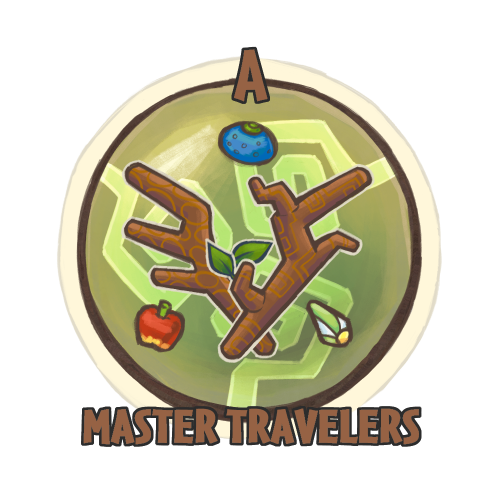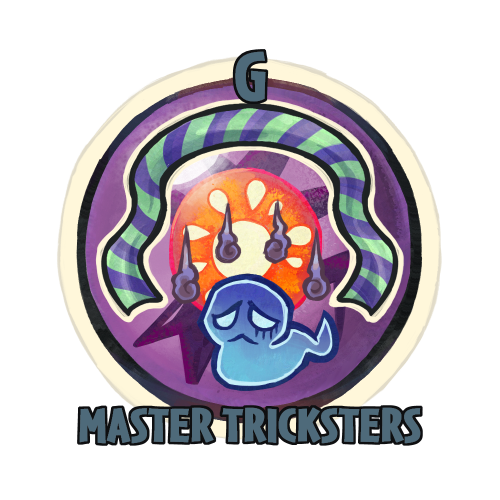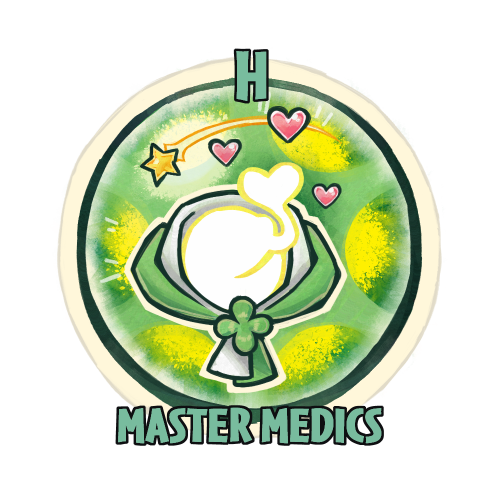(Disclaimer: This is not a Gameplay Guide. If you want information on how the PMD2 IQ Groups play in-game, I recommend referring to RatFatKnight's IQ Skill Guide.)
Sources
Bulbapedia's List of Pokemon by IQ GroupBulbapedia's List of IQ Skills
Serebii's List of IQ Skills
RatFatKnight's IQ Skill Guide (GameFAQs)
Renaming the Pokemon Mystery Dungeon IQ Groups
I've been thinking about old Pokemon mechanics recently and thinking about the direction Pokemon Mystery Dungeon: Rescue Team DX has taken the series as a reimagining of the original where I remembered that the IQ system was replaced with the Rare Quality system in a move some older PMD fans have found controversial. As someone whose played every game in the series since Pokemon Mystery Dungeon: Explorers of Sky, I've always found the IQ system deeply unsatisfying just due to how hard it is to actually grind your IQ stat, as I've been unable to get my Hero and Partner pokemon higher than maybe 2 and a half IQ ranks in a standard story campaign. Perhaps because of this, I'm a deep appreciator of the simplified Rare Quality system and would happily see it return when a new game comes out.
That said, knowing how deep PMD goes with its gameplay-story integration, I do have this desire to "solve" what these IQ groups mean in terms of how the series characterizes its Pokemon inhabitants even with small details like this, which is easier said then done. When I first got into this topic, honestly, the thing that baffled me the most is that the PMD devs made up these whole new categories of Pokemon when in my head, just reusing the Egg Groups from the mainline games would have probably worked just fine, instead of creating this whole new system without even bothering to give them helpful names like the Field, Fairy, and Monster categories used by Egg Groups. Instead, Group A and Group J don't actually tell me anything about the Pokemon these IQ groups get assigned to, so I'm taking it upon myself to give these categories names that I think are reflective of the developers' reasons for putting Caterpie, Unown and Shaymin in the same Group and maybe entertain you along the way. So without further ado, let's begin.
Group A - Master Travelers

Group A Skill List
Skills marked with * are gained in the same order across every group
| *Escapist | *Course Checker | *Item Catcher | *Item Master |
| *Exclusive Move-User | *Status Checker | *Nontraitor | *Lava Evader |
| Collector | Haggler | Nonsleeper | Type-Advantage Master |
| Pierce Hurler | Dedicated Traveler | House Avoider | Trap Buster |
| Coin Watcher | Survivalist | PP Saver | Stair Sensor |
| All-Terrain Hiker | Multitalent | Acute Sniffer | Map Surveyor |
Example Members: Caterpie family, Diglett family, Magnemite family, Dunsparce, Snorunt family, Shaymin
Overview
Typically assigned to early game bug types, ground types, ice types, and otherwise mysterious or rare Pokemon like Magnemite, Ditto, and Unown. Excels at gathering items and navigating long dungeons.
Read More
Interestingly, Group A from what I've been able to tell doesn't have any Pokemon from the Starter pool in Pokemon Mystery Dungeon: Explorers of Sky, and consists of eclectic mix of Pokemon ranging from common Bug Types like the Caterpie line, the Weedle line, the Paras line, the Venonat line, and the Wurmple family to more mysterious Pokemon like the Magnemite line, Ditto, Unown, and even my mascot Shaymin. In a way Group A is possibly the best example of why I've found the IQ system so mysterious because this group seems to be all over the place.
Looking at the skills this group learns, I ended up coming to the conclusion that this IQ Group are supposed be Pokemon that excel at Traveling, as illustrated by most of their high level skills helping with item management and navigation, which led me to naming this group the "Master Travelers".
By the way, the Example Pokemon list I'm going to make for these will typically include either starter families, Legendaries and Mythicals, or the evolution lines of any Pokemon that appears as an important NPC throughout the series. For example, Shaymin, as a member of this group is an NPC that helps you travel up to Sky Peak as a guide.
Group B - Master Bards

Group B Skill List
Skills marked with * are gained in the same order across every group
| *Escapist | *Course Checker | *Item Catcher | *Item Master |
| *Exclusive Move-User | *Status Checker | *Nontraitor | *Lava Evader |
| Haggler | Nonsleeper | Type-Advantage Master | Pierce Hurler |
| Dedicated Traveler | House Avoider | Trap Buster | Coin Watcher |
| Gap Prober | Trap Seer | Cheerleader | Bodyguard |
| Wise Healer | Deep Breather | Fast Friend | Nature Gifter |
Notable Skills: Cheerleader, Deep Breather, Wise Healer, Fast Friend, Trap Seer, House Avoider, Nature Gifter
Example Members: Jigglypuff family, Sunkern Family, Celebi, Whismur family, Jirachi, Chatot, Phione, Manaphy
Typically assigned to normal types, fairy types, grass types, water types, Pokemon associated with music, and 100-stat mythical Pokemon. Excels at raising the stats of your allies and recruiting new teammates.
Read More
Right off the bat, this group seems to be a favorite of the Wigglytuff Guild being represented by Wigglytuff, Sunflora, Loudred, Corphish, Chimecho and Chatot. This is one of the two IQ Groups that seem to be built around healing support, though this one is notably missing some of the most famous healing Pokemon like Chansey and Cresselia. I want to call this group the "Master Bards" based on the presence of music-associated Pokemon like Jigglypuff, Loudred, Chimecho and Chatot and their support based playstyle. Also I think this is the group with the most Mythical Pokemon in it with Celebi, Jirachi and Manaphy.
Group C - Master Fighters

Group C Skill List
Skills marked with * are gained in the same order across every group
| *Escapist | *Course Checker | *Item Catcher | *Item Master |
| *Exclusive Move-User | *Status Checker | *Nontraitor | *Lava Evader |
| Nonsleeper | Type-Advantage Master | Pierce Hurler | Survivalist |
| Counter Basher | Clutch Performer | Practice Swinger | Extra Striker |
| Concentrator | Brick-Tough | Power Pitcher | Intimidator |
| No-Charger | Erratic Player | Exp. Go-Getter | Aggressor |
Example Members: Fire Starter families, Legendary Bird Trio, Mewtwo, Seedot family, Meditite family, Shinx family, Riolu family, Heatran, Giratina
Typically assigned to fire types, fighting types, and powerful Pokemon like pseudo legendaries and Legendaries. Excels at dealing damage and defeating enemies.
Read More
This group was much easier for me to define than the last two as the Pokemon List and Skill List both screamed "DPS". Not much to say here to be honest, other than I think this group probably has the most Starter families in it so far.
Another small trivia note is that this group has the most type variety out of all of the IQ groups. The more you know.
Group D - Master Rangers

Group D Skill List
Skills marked with * are gained in the same order across every group
| *Escapist | *Course Checker | *Item Catcher | *Item Master |
| *Exclusive Move-User | *Status Checker | *Nontraitor | *Lava Evader |
| Dedicated Traveler | PP Saver | Stair Sensor | Gap Prober |
| Trap Seer | Clutch Performer | Practice Swinger | Extra Striker |
| Concentrator | Counter Hitter | Self-Curer | Sharpshooter |
| Trap Avoider | Quick Striker | Critical Dodger | Quick Dodger |
Example Members: Pikachu family, Machop family, Marill family, Scizor, Ho-oh, Legendary Beast Trio, Treeko family, Latias, Latios, Rayquaza, Buneary family
Typically assigned to fast flying types, bug types, dragon types, quadrupedal Pokemon, rabbit inspired Pokemon and groups of Legendaries like the Legendary Beasts and the Eon Duo. Excels at good luck, evasion, and accuracy.
Read More
Another straight forward Group that is mostly defined by evasion skills, giving the player extra turns, and accuracy. Most of the Pokemon on this list are speedy flying types but there is one family I do have umbrage with. The Machop family should really be in Group C but oh well. I think that calling this group the "Master Rangers" works best for capturing this group's need for speed and synergy with projectile items.
Group E - Master Defenders

Group E Skill List
Skills marked with * are gained in the same order across every group
| *Escapist | *Course Checker | *Item Catcher | *Item Master |
| *Exclusive Move-User | *Status Checker | *Nontraitor | *Lava Evader |
| House Avoider | Survivalist | Cheerleader | Bodyguard |
| Wise Healer | Deep Breather | Brick Tough | Power Pitcher |
| Defender | Energy Saver | Sure-Hit Attacker | Efficiency Expert |
| Wary Fighter | Quick Healer | Counter Hitter | Intimidator |
Example Members: Squirtle family, Snorlax family, Totodile family, Phanpy family, Anorith family, The Regi Quartet, Kyogre, Groudon, Turtwig family
Typically assigned to water types, rock types, steel types, Pokemon with shells, and Powerful tanky pokemon like pseudo legendaries, the Regi Quartet, and Groudon and Kyogre. Excels at taking hits and hunger management.
Read More
If you haven't already caught on, this group seems to dedicated to defensive skills and iconic tanky Pokemon, making them easy to define as "Master Defenders". This is another group with a fair amount of PMD starter representation.
Group F - Master Tacticians

Group F Skill List
Skills marked with * are gained in the same order across every group
| *Escapist | *Course Checker | *Item Catcher | *Item Master |
| *Exclusive Move-User | *Status Checker | *Nontraitor | *Lava Evader |
| PP Saver | Self-Curer | Type-Advantage Master | Weak-Type Picker |
| Gap Prober | Wary Fighter | Sharpshooter | Hit-and-Runner |
| Multitalent | Exp. Elite | All-Terrain Hiker | Trap Buster |
| Stair Sensor | No-Charger | House Avoider | Pierce Hurler |
Example Members: Bulbasaur family, Abra family, Cubone family, Eevee family, Mareep family, Sneasle family, Lugia, Mudkip family, Ralts family, Duskull family, Deoxys, Piplup family, Bidoof family
Typically assigned to psychic types, early game normal types, Pokemon that change or gain types by evolving, ghost types, and Pokemon associated with high intelligence and adaptability. Excels at targeting weak points, managing Power Points, and providing utility.
Read More
This is an interesting one that had me scratching my head for a while. For starters, this group contains the largest number of starters thanks to the Eevee family and if you count Cubone from PMD1. Eventually, based on the number of skills that focus on type matchups and EXP growth, I ended up on defining this group as the "Master Tacticians", which actually works surprisingly well as this group also contains many Pokemon the PMD series has portrayed as knowledgable explorers like Alakazam, Gardevoir, and Dusknoir.
Group G - Master Tricksters

Group G Skill List
Skills marked with * are gained in the same order across every group
| *Escapist | *Course Checker | *Item Catcher | *Item Master |
| *Exclusive Move-User | *Status Checker | *Nontraitor | *Lava Evader |
| Acute Sniffer | PP Saver | Self-Curer | Practice Swinger |
| Exp. Go-Getter | Trap Avoider | Hit-and-Runner | Quick Healer |
| Exp. Elite | Erratic Player | Critical Dodger | Stair Sensor |
| Quick Dodger | Map Surveyor | Trap Seer | Quick Striker |
Example Members: Vulpix family, Meowth family, Gastly family, Wooper family, Skitty family, Kecleon, Stunky family, Spiritomb, Lake Spirit Trio
Typically assigned to ghost types, poison types, dark types, bug types, and cat-like Pokemon. Excels at exploring dungeons and getting out of danger.
Read More
Another less straightforward group that I was mulling over when trying to define it. I eventually settled on "Master Tricksters" due to the wide variety of skills and the amount of "Trickstery" pokemon in this group. For example, this group consists of a mix of Poison, Dark, Ghost, and Bug types that fit into this idea.
Group H - Master Medics

Group H Skill List
Skills marked with * are gained in the same order across every group
| *Escapist | *Course Checker | *Item Catcher | *Item Master |
| *Exclusive Move-User | *Status Checker | *Nontraitor | *Lava Evader |
| Efficiency Expert | Bodyguard | Self-Curer | Brick Tough |
| Coin Watcher | Wise Healer | Wary Fighter | Deep Breather |
| Quick Healer | All-Terrain Hiker | Trap Buster | Critical Dodger |
| Quick Dodger | Fast Friend | House Avoider | Nature Gifter |
Example Members: Mew, Chikorita family, Roselia family, Cresselia
Typically assigned to water types, normal types, fairy types, grass types, flying types and Pokemon strongly associated with healing. Excels at protecting the party, evading attacks, and recruiting teammates.
Read More
The last of the main IQ Groups and the second Healing based group I mentioned back with Group B. Interestingly, this group has a few of the skills from the "tanky" group like Bodyguard, Brick-Tough, and Wary Fighter that almost made me call this group the "Master Paladins", but I settled on calling them the "Master Medics" to not totally bog this project down with RPG jargon. Another thing about this group I find interesting is the large amount of flying Pokemon like Togekiss, Jumpluff, Mantine, and Altaria which also give this group a bit of Angel themeing? Not sure, but I wanted to share my observations.
Group I - Time Warpers
Notable Skills: Aggressor, All-Terrain Hiker, Extra Striker, Intimidator, Time Tripper
Example Members: Dialga, Darkrai, Arceus (Wii Only)
Read More
And here's the Group that really set this project into motion because here we get a clear-cut example of that Gameplay-Story Integration I was talking about. Darkrai, as we know them from the mainline games, really has no reason to share an IQ Group with Dialga for the exclusive "Time Tripper" skill except for the specific story reasons we have from the Pokemon Mystery Dungeon: Explorers titles. Also, apparently Arceus is also a member of this exclusive IQ Group but only where it appears in the WiiWare games. Interesting!
Group J - Space Warpers
Notable Skills: Defender, Multi-Talent, Sure-Hit Attacker, Intimidator, Absolute Mover
Example Member: Palkia
Read More
Apparently the PMD2 devs felt bad about giving so much story attention to Dialga instead of Palkia so the Spatial Pokemon instead gets an exlusive IQ Group all to themself with the OP Skill "Absolute Mover". Unfortunately, these Legendary exclusive Groups don't have much to actually analyze but it's neat that the devs went out of the way to give the most cosmically powerful Pokemon in the PMDverse the skills to match. Still, I think adding Giratina to this group would help make it feel a little less neglected and it's distortion powers can be easily read as Spatial manipulation but that's just my take.
The End!...for now?
 Links
Links
| Tumblr: | @shaymin-sylph |
| Bluesky Social: | @shaymin-sylph |
| artfight: | @sylph-of-eons |
| AO3: | @sylph_of_eons |
| Youtube Channel: | Graymin |
| Sheezy.Art: | @Graymin |



